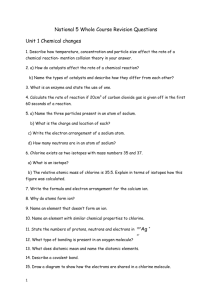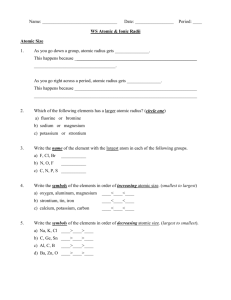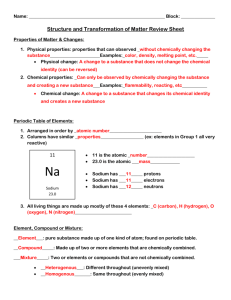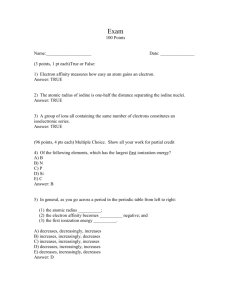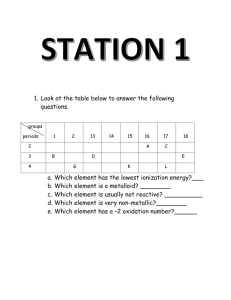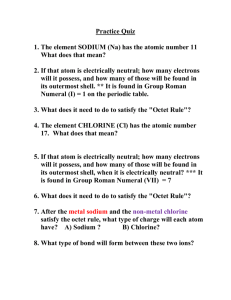File
advertisement
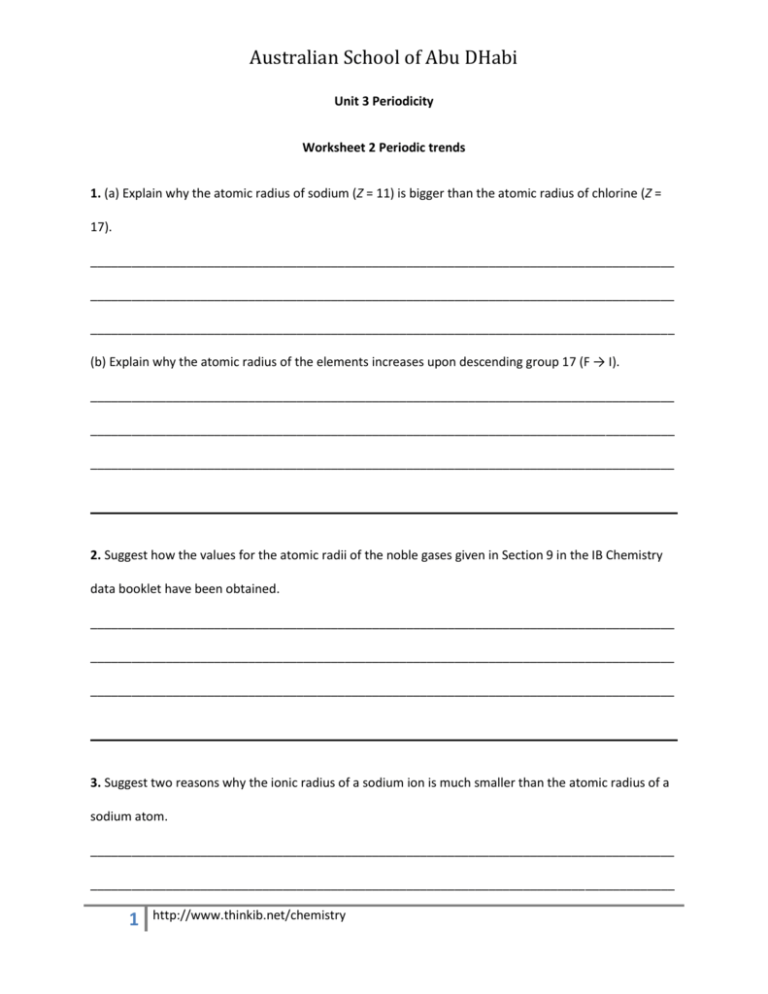
Australian School of Abu DHabi Unit 3 Periodicity Worksheet 2 Periodic trends 1. (a) Explain why the atomic radius of sodium (Z = 11) is bigger than the atomic radius of chlorine (Z = 17). _____________________________________________________________________________________ _____________________________________________________________________________________ _____________________________________________________________________________________ (b) Explain why the atomic radius of the elements increases upon descending group 17 (F → I). _____________________________________________________________________________________ _____________________________________________________________________________________ _____________________________________________________________________________________ 2. Suggest how the values for the atomic radii of the noble gases given in Section 9 in the IB Chemistry data booklet have been obtained. _____________________________________________________________________________________ _____________________________________________________________________________________ _____________________________________________________________________________________ 3. Suggest two reasons why the ionic radius of a sodium ion is much smaller than the atomic radius of a sodium atom. _____________________________________________________________________________________ _____________________________________________________________________________________ 1 http://www.thinkib.net/chemistry Australian School of Abu DHabi 4. Three negative ions are the phosphide ion, P3–, the sulfide ion, S2– and the chloride ion, Cl–. Place these three ions in order of increasing size (smallest first) and explain your logic. _____________________________________________________________________________________ _____________________________________________________________________________________ _____________________________________________________________________________________ _____________________________________________________________________________________ 5.Give the equations for the reaction of water with: (a) sodium oxide, Na2O. _____________________________________________________________________________________ (b) magnesium oxide, MgO _____________________________________________________________________________________ (c) phosphorus(V) oxide, P4O10 _____________________________________________________________________________________ (d) sulfur(VI) oxide, SO3. _____________________________________________________________________________________ 6.Describe and explain (with a relevant equation) what will be observed when chlorine water is added to: (a) a solution of chloride ions. _____________________________________________________________________________________ 2 http://www.thinkib.net/chemistry Australian School of Abu DHabi _____________________________________________________________________________________ (b) a solution of bromide ions. _____________________________________________________________________________________ _____________________________________________________________________________________ (c) a solution of iodide ions. _____________________________________________________________________________________ ____________________________________________________________________________________ 7. State what will be observed when sodium metal is placed in water and give the equation for the reaction. _____________________________________________________________________________________ _____________________________________________________________________________________ _____________________________________________________________________________________ 8. Suggest one reason why caesium is more reactive than lithium when it is placed in water. _____________________________________________________________________________________ _____________________________________________________________________________________ 9. State what will be observed when a piece of warm sodium metal is lowered into in a gas jar containing chlorine gas and give the equation for the reaction. _____________________________________________________________________________________ 3 http://www.thinkib.net/chemistry Australian School of Abu DHabi _____________________________________________________________________________________ _____________________________________________________________________________________ 10. Aluminium oxide, Al2O3, has a high melting point and it reacts with both hydrochloric acid and sodium hydroxide. What information can be deduced about the chemical nature of aluminium oxide from this information? _____________________________________________________________________________________ _____________________________________________________________________________________ _____________________________________________________________________________________ 4 http://www.thinkib.net/chemistry Australian School of Abu DHabi Answers 1. (a) Chlorine has 7 electrons in the third energy level and sodium only has one. The seventeen protons in the nucleus of the chlorine atom attract the energy level more strongly than the eleven protons in the sodium atom thus making the chlorine atom smaller. (b) The outer electrons are further away from the nucleus as they are in successively higher energy levels. 2. Atomic radii are normally obtained by measuring half the distance between two bonded atoms. Noble gases (essentially) do not bond with other atoms so the radius is obtained by measuring the distance between the atoms when the noble gas is in the frozen state.(It is known as the non-bonding atomic radius or van der Waals' radius). 3. (i) The outer electron in the sodium atom is in the third energy level, once this is removed the outer level of the electrons in the sodium ion is the second energy level. (ii) There are more protons than electrons in the sodium ion which attracts the outer energy level closer to the nucleus. 4. Cl– < S2– < P3–. They all have the same electron configuration (1s22s22p63s23p6), but the 17 protons in the Cl– ion attract the outer electrons more closely to the nucleus than the 15 protons in the P3– ion. 5. (a) Na2O(s) + H2O(l) → 2NaOH(aq) (b) MgO(s) + H2O(l) → Mg(OH)2(s) (magnesium hydroxide is only sparingly soluble in water) (c) P4O10(s) + 6H2O(l) → 4H3PO4(aq) (d) SO3(g) + H2O(l) → H2SO4(aq) 6. (a) There is no change as there is no reaction between chlorine and a solution of chloride ions. (b) A yellow/brown solution will be formed. This is due to the formation of bromine. Cl2(aq) + 2Br–(aq) → 2Cl–(aq) + Br2(aq) (c) A dark brown solution will be formed. This is due to the formation of iodine. (The presence of iodine can be confirmed by shaking with a little non-polar organic solvent such as heptane. When the two layers are allowed to separate the non-polar organic layer will be purple). Cl2(aq) + 2I–(aq) → 2Cl–(aq) + I2(aq) 5 http://www.thinkib.net/chemistry Australian School of Abu DHabi 7. The sodium metal melts into a ball and floats on the surface. It reacts vigorously giving off heat and a gas until eventually it all disappears. The solution remains colourless. During the reaction small yellow sparks may be observed. Na(s) + 2H2O(l) → 2NaOH(aq) + H2(g) 8. The simplistic (Standard Level) answer is that the outer electron in caesium is further from the nucleus than the outer electron in lithium so requires less energy to remove. Some critical thinking will show that it is not as simple as this. The general reaction is M(s) + 2H2O(l) → M+(aq) + 2OH– (aq) + H2(g) The first ionization energy of caesium is lower: M(g) → M+(g) + e– but first the metal must be turned into a gas. Again less energy is required for caesium for the process M(s) → M(g). The final change is the formation of the aqueous ion M+(g) → M+(aq). This is an exothermic process. Because of the small size of the lithium ion, lithium gives out more heat than caesium in this process as it attracts water molecules more as the density of charge is greater. Overall the total energy changes for the two metals are very similar. It would appear that the heat change in the two reactions is similar but caesium gives heat out much quicker. This may be because it has a lower melting point and so provides a greater surface area for the reaction to proceed faster. 9. The sodium metal burns in the green gas producing a bright light and clouds of white smoke. The green colour disappears (unless the chlorine is in large excess) and a white solid remains. 2Na(s) + Cl2(g) → 2NaCl(s) 10. (i) As the melting point is high the bonding is ionic. (ii) As it reacts with both acids and bases it is an amphoteric oxide. 6 http://www.thinkib.net/chemistry


